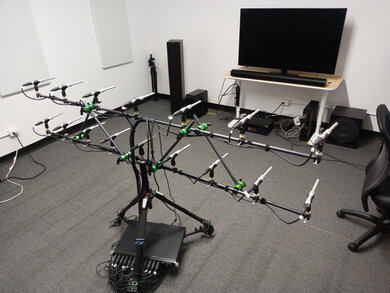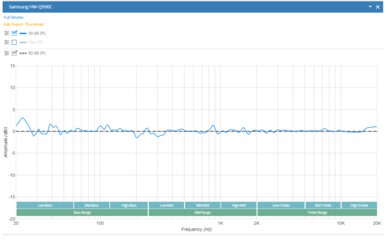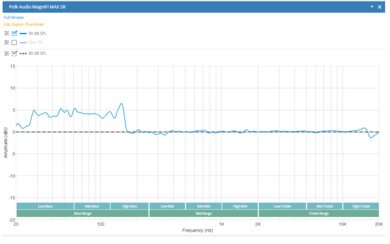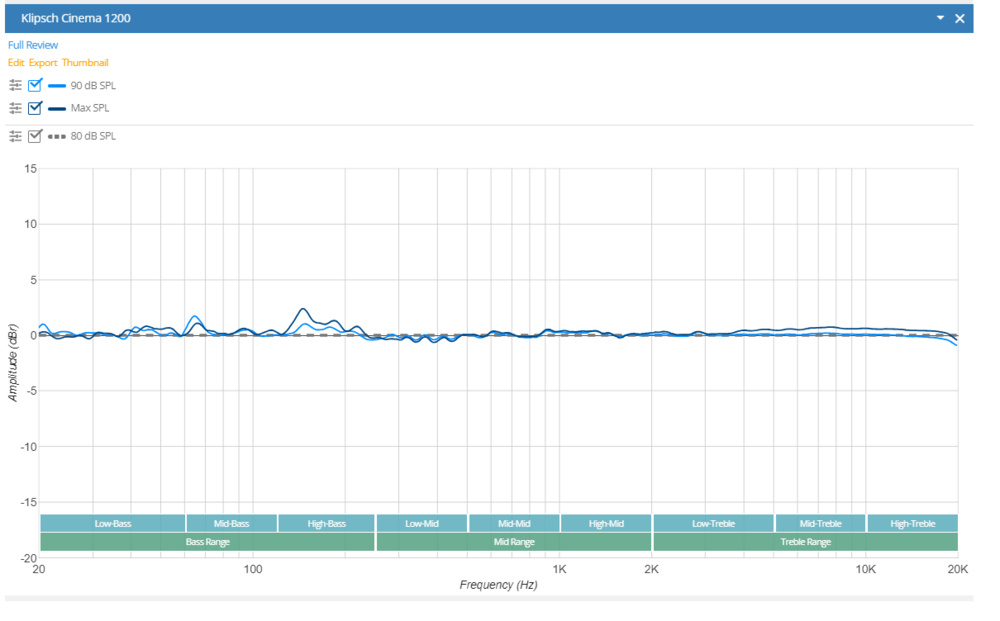- 60.0%SPL @ Max Volume
- 20.0%DRC @ 90dB
- 20.0%DRC @ Max Volume
Our stereo dynamics tests are ideal for listeners who like to crank up the volume when listening to their favorite music and movies. If you're looking to fill up a large space or listen to music at crowded parties, you'll want a soundbar that can get loud. You'll also want a soundbar that maintains clean and pure audio reproduction when it's pushed to loud volumes. Otherwise, noticeable pumping and compression artifacts could take away from the quality of your listening experience.
Our tests measure how loud a soundbar gets. Also, we check to see how much compression is present at a volume of 90 decibels, as well as at the bar's maximum volume.
Test results
When It Matters
If you like to crank up the volume, you'll want a soundbar with a good dynamics performance. A soundbar that can get loud is especially useful for listeners who need to fill up a large room or a crowded space, like a party. However, not all soundbars perform well at loud volumes. Some models have noticeable pumping and compression artifacts at louder volumes, which make audio noticeably louder, then quieter in quick succession. If you want your audio to sound the same at max volume compared to normal listening volumes, you'll also want a soundbar without a lot of dynamic range compression at max volume.
Our Tests
To measure a soundbar's dynamics performance, we record its Sound Pressure Level @ Max Volume and its Dynamic Range Compression @ 90dB and at Max Volume. These measurements give you a better understanding of how loud the soundbar gets and whether or not the audio reproduction noticeably degrades when listening at louder volumes.
We perform our dynamics tests during our stereo frequency response accuracy and stereo soundstage testing with a sine wave tone at -6 dB FS between 20 Hz and 20 kHz. We use a room that's 20' (L) x 16' (W) x 9.5' (H), with one couch and minimal sound treatment to represent a typical living room. The soundbar and the table it sits on are placed 7.5 feet away from our microphone array. We use a laser measuring tool to ensure that the microphone array, the table, and the soundbar are at the appropriate distance from the side walls, as well as the subwoofer and the satellites if they're included in the setup.

Stereo SPL @ Max Volume
The Sound Pressure Level @ Max Volume is a measurement that shows how loud a soundbar can get when it's pushed to its maximum volume. This measurement is recorded in decibels (dB) using a microphone array. It can be helpful for listeners who like to crank up the volume, especially for listening to audio in large rooms or at crowded parties.
While we set this measurement's "good" value at 92 dB or higher, you may have different preferences depending on your listening habits and how large your listening space is. It can be helpful to remember that the SPL measurement system was designed with the human ear in mind, so a ten-decibel increase in volume is perceived as doubling the loudness of the soundbar. For example, a soundbar at 92 dB is perceived to be twice as loud as a soundbar at 82 dB and four times as loud as a soundbar at 72 dB. Most of the products we've tested have an SPL @ Max Volume between 82 and 100 dB SPL.
Stereo DRC @ 90 dB
A soundbar that can get loud is helpful for listeners who like to crank up the volume. However, some soundbars can't reproduce audio content with the same quality at higher volumes, which may negatively impact your listening experience. At louder listening volumes, some soundbars have pumping and compression artifacts. This can quickly make your audio louder, then quieter. As a result, your audio content isn't reproduced as purely or clearly as it is at typical listening volumes. This is most noticeable with music and movies, but it may not be as obvious with dialogue-centric content like TV shows.
Dynamic Range Compression @ 90 dB is a measurement that compares the soundbar's stereo frequency response at a more normal listening volume to its stereo frequency response at 90 dB. For this test, we record the bar's frequency response at a regular listening volume of 80 dB SPL and again at 90 dB SPL using the microphone array. If a soundbar has a maximum volume of less than 90 dB, we'll perform this measurement at its highest possible volume. The DRC @ 90 dB represents the amount of difference between the two measurements, recorded in decibels.
The lower the DRC @ 90 dB, the better since it represents less of a change in the audio reproduction when the bar is pushed to a higher volume. That said, a DRC @ 90 dB measurement of less than 2 dB likely won't be too noticeable for most listeners.


Stereo DRC @ Max Volume
Want to turn it up even louder? Check out your soundbar's DRC performance at maximum volume. This measurement is designed to evaluate audio reproduction quality when you turn the bar up as loud as it can go. We use a similar methodology to the test at 90 dB: first, we record the bar's frequency response at 80 dB SPL and then record it again at its maximum volume. The DRC @ Max Volume value represents the difference between the two, recorded in decibels. The lower the value, the less compression and pumping artifacts you hear.
With most soundbars, you'll notice a bit more compression at maximum volume than at 90 decibels. Again, it's not likely to be noticeable with real-life content if the value falls under 2 dB. We'll skip this test if a soundbar doesn't get louder than 90 dB.

Conclusion
Love to crank up the volume? For many listeners, it's important to find a soundbar that gets loud without noticeably degrading the quality of the audio content. Our stereo dynamics tests can give you a better understanding of how loud a soundbar gets and how much compression there is when you play it at louder volumes. Most listeners will want something that gets loud without a lot of compression to ensure that they can rock out to their favorite tunes with the best possible audio quality.